WordPress affiche le même menu de navigation pour tout le monde. Cependant, vous pourriez vouloir personnaliser le menu selon qu’un client/cliente est connecté ou non.
Afficher des menus différents pour les utilisateurs/utilisatrices connectés dans WordPress est un excellent moyen de créer une expérience plus personnalisée. Il vous permet d’afficher un contenu pertinent uniquement à ceux qui sont connectés, comme les détails du compte ou des ressources exclusives.
Dans ce guide, nous allons expliquer comment configurer différents menus pour les utilisateurs/utilisatrices connectés en utilisant 2 méthodes.
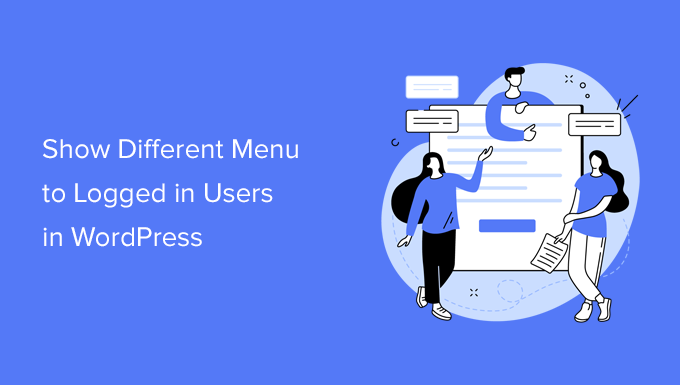
Pourquoi afficher des menus différents pour les utilisateurs/utilisatrices connectés dans WordPress ?
Modifier les différentes zones de votre site WordPress en fonction de vos internautes et de leur activité donne à votre site une impression de personnalisation pour chaque compte.
Ce contenu personnalisé vous aide à améliorer l’expérience des utilisateurs sur votre site WordPress.
Si vous gérez un site web sur lequel les utilisateurs/utilisatrices n’ont pas besoin de s’inscrire ou de se connecter, vous pouvez probablement utiliser les mêmes menus de navigation sur l’ensemble de votre site. En revanche, d’autres sites peuvent tirer un grand profit de l’affichage de menus personnalisés pour les utilisateurs/utilisatrices connectés.
Par exemple, les sites web tels qu’un magasin en ligne, une plateforme d’apprentissage en ligne ou une communauté de sites d’adhésion WordPress, peuvent tous bénéficier de menus de navigation personnalisés.
Un menu de navigation personnalisé pour les utilisateurs/utilisatrices connectés les aide à trouver plus facilement ce pour quoi ils se sont inscrits.
Par exemple, un compte peut être géré par un utilisateur/utilisatrice sur une boutique en ligne, ou un membre d’une communauté payante peut facilement renouveler son abonnement ou voir les cours en ligne exclusifs qu’il a achetés.
Par défaut, WordPress vous permet de créer autant de menus de navigation que vous le souhaitez. Cependant, vous pouvez uniquement choisir d’afficher un seul menu à un Emplacement particulier dans votre thème WordPress.
Avant de définir des menus pour les utilisateurs connectés, vous devez d’abord créer deux menus de navigation distincts. L’un sera destiné aux utilisateurs/utilisatrices connectés, l’autre aux utilisateurs/utilisatrices déconnectés. Premiers pas.
Une petite note ! Les méthodes que nous partageons sont conçues pour les personnes utilisant des thèmes WordPress classiques. Si vous utilisez un thème basé sur blocs avec des fonctionnalités d’Éditeur de site complet (Éditeur de site) à partir de WordPress 5.8, cette méthode pourrait ne pas fonctionner.
Créer des menus pour les utilisateurs/utilisatrices connectés et non connectés dans WordPress
Pour créer des menus distincts pour les deux types d’utilisateurs, vous devez vous rendre sur la page Apparence ” Menus dans le Tableau de bord WordPress.
Si vous disposez déjà d’un menu de navigation que vous utilisez sur votre site pour tous les utilisateurs/utilisatrices, celui-ci peut être votre menu par défaut.
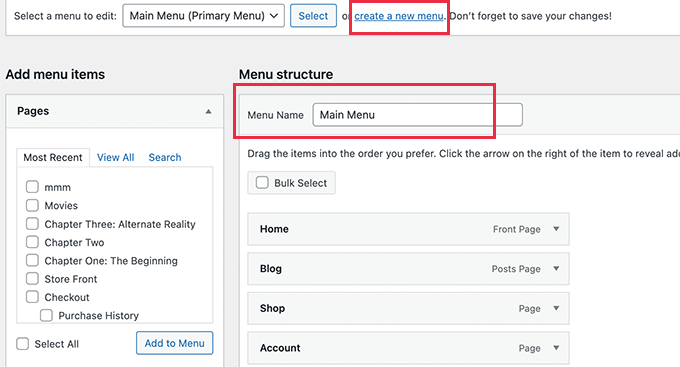
Ensuite, vous pouvez cliquer sur le lien “créer un nouveau menu” pour créer un nouveau menu personnalisé pour vos utilisateurs/utilisatrices connectés.
Ici, vous pouvez ajouter les éléments de menu que vous souhaitez afficher aux utilisateurs/utilisatrices inscrits ou connectés. Par exemple, vous pouvez ajouter un lien de déconnexion à votre menu.
Sur le côté gauche de l’écran, vous pouvez voir une liste des pages de votre site. Il vous suffit de cocher la case située à côté de la page que vous souhaitez ajouter à votre menu et de cliquer sur le bouton “Ajouter au menu”.
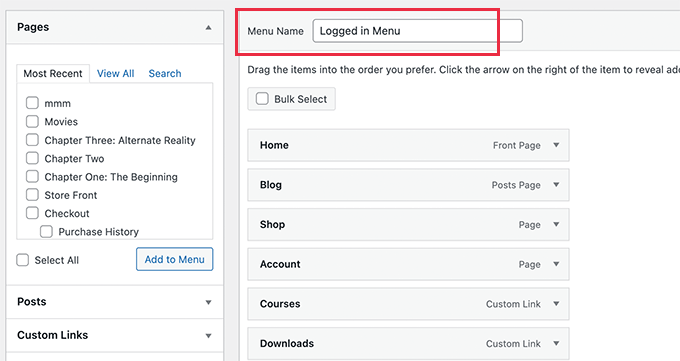
Vous pouvez également faire glisser les éléments de menu sur le côté droit de l’écran pour les réorganiser.
Plus bas dans la page, vous pouvez choisir un Emplacement pour afficher votre menu. Mais il n’est pas nécessaire d’assigner un emplacement à ce menu pour l’instant. Nous le ferons ultérieurement dans cet article.
N’oubliez pas de cliquer sur le bouton “Enregistrer le menu” pour stocker vos modifications.
Pour plus de détails sur la création de menus, consultez notre guide du débutant sur les menus de navigation WordPress.
Vous êtes maintenant prêt à afficher différents menus aux utilisateurs/utilisatrices connectés. Voici un aperçu rapide de toutes les méthodes que nous allons aborder dans ce guide :
Examinons la première méthode.
Méthode 1. Afficher des menus différents pour les utilisateurs/utilisatrices connectés dans WordPress à l’aide d’un plugin
La façon la plus simple d’afficher différents menus aux utilisateurs/utilisatrices connectés est d’utiliser le plugin Conditional Menus. Commençons donc par l’installer et l’activer.
Pour plus de détails, vous pouvez consulter notre guide étape par étape sur l’installation d’une extension WordPress.
Une fois activé, vous devrez naviguer vers Apparence ” Menus depuis votre Tableau de bord WordPress. Ensuite, passez à l’onglet ” Gérer les emplacements “.
À partir de cette page, vous verrez la liste des Emplacements de menu disponibles définis dans votre thème WordPress et les menus qui s’affichent actuellement.
Par exemple, notre emplacement “Menu principal” affiche actuellement un “Menu principal”.
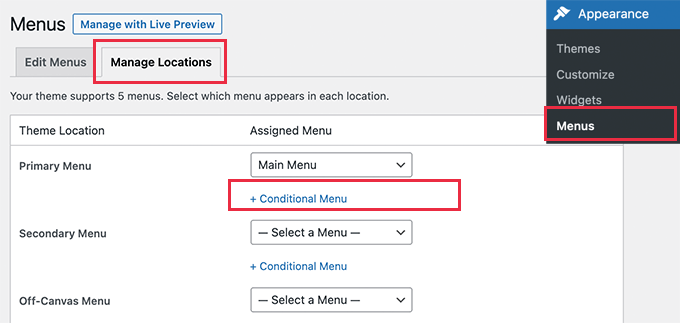
Nous devons maintenant demander à l’extension d’afficher un menu différent lorsqu’une certaine condition est remplie.
Pour ce faire, cliquez sur le lien “+ Menu conditionnel”. Ensuite, vous pouvez sélectionner dans le menu déroulant le menu de navigation que vous souhaitez afficher aux utilisateurs/utilisatrices connectés.

Cliquez ensuite sur le lien “+ Conditions”.
Une fenêtre surgissante s’affiche, dans laquelle vous pouvez choisir parmi plusieurs conditions.
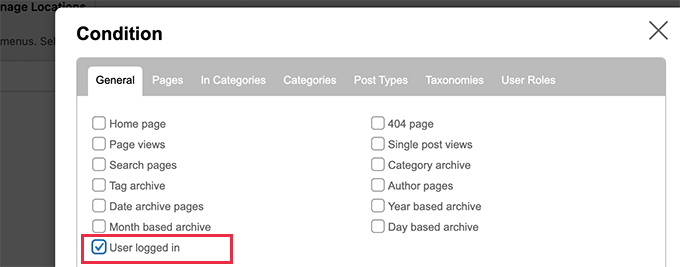
Il suffit de cocher la case située à côté de l’option “Utilisateur connecté”, puis de cliquer sur le bouton “Enregistrer”.
Vous pouvez maintenant visiter votre site pour voir le menu des utilisateurs/utilisatrices connectés en action. Vous pouvez également vous déconnecter de votre administration WordPress pour voir le menu de navigation qui sera affiché à tous les autres utilisateurs/utilisatrices.
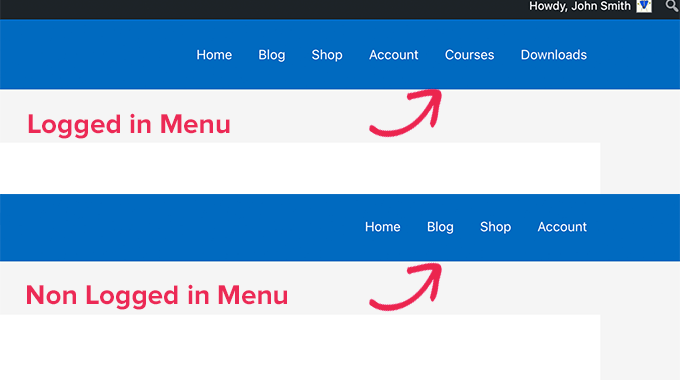
Méthode 2. Sélectionner manuellement le menu des personnes connectées dans WordPress à l’aide d’un code
Cette méthode nécessite d’ajouter du code à votre site WordPress. Si vous ne l’avez jamais fait auparavant, consultez notre guide sur la manière de copier et coller des extraits de code dans WordPress.
En général, vous devez ajouter un extrait de code au fichier functions.php de votre thème ou à une extension spécifique à votre site. Cependant, nous ne recommandons pas cette méthode car elle peut potentiellement causer des problèmes avec votre site.
A la place, vous pouvez utiliser l’extension WPCode.
WPCode vous permet d’ajouter des extraits de code personnalisés à votre site sans modifier directement les fichiers du thème. Il aide également à gérer ces extraits et s’assure qu’ils sont exécutés en toute sécurité, minimisant ainsi le risque de casser votre site.
Pour Premiers pas, installons l’extension WPCode. Vous pouvez utiliser la version gratuite de WPCode, car elle contient tout ce dont vous avez besoin pour afficher différents menus aux utilisateurs/utilisatrices connectés.
Une fois installé, vous voudrez naviguer vers Extraits de code “ + Ajouter des extraits.
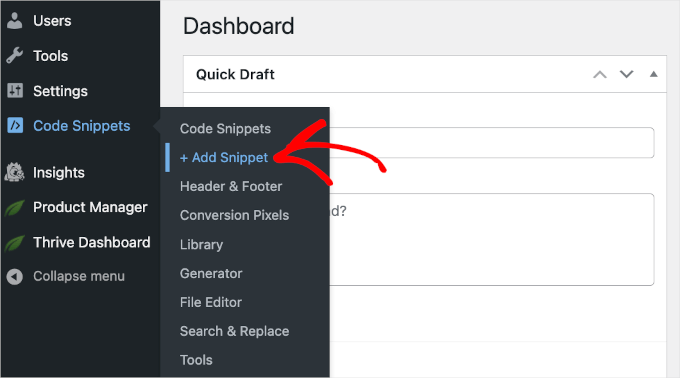
La galerie d’extraits de code de WPCode s’ouvre alors.
À partir de là, vous pouvez cliquer sur le bouton “+ Ajouter un extrait personnalisé”.
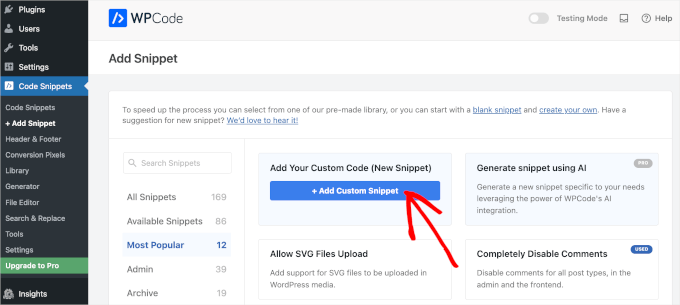
Vous arrivez alors dans l’éditeur de texte du WPCode.
L’étape suivante consiste à ajouter un titre à votre extrait de code et à choisir “Extrait HTML” dans le menu déroulant “Type de code”.
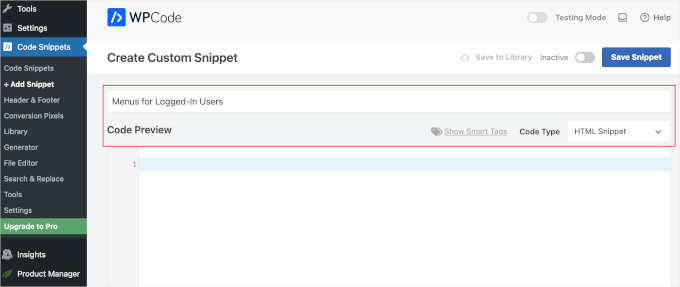
Une fois cela fait, il suffit de copier et de coller le code suivant dans le champ “Prévisualisation du code” :
1 2 3 4 5 6 7 8 9 10 11 12 | function my_wp_nav_menu_args( $args = '' ) {if( is_user_logged_in() ) {// Logged in menu to display$args['menu'] = 43;} else {// Non-logged-in menu to display$args['menu'] = 35;}return $args;}add_filter( 'wp_nav_menu_args', 'my_wp_nav_menu_args' ); |
Voici à quoi cela pourrait ressembler dans votre éditeur/éditrices WPCode :
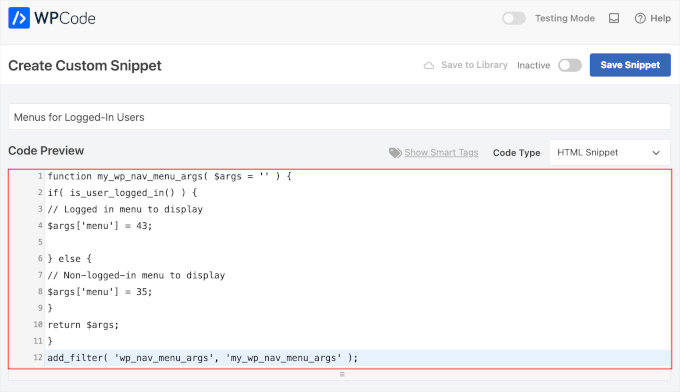
Confirmez que vous remplacez 43 et 35 par les ID des menus de navigation que vous avez créés précédemment.
Vous pouvez trouver l’ID d’un menu de navigation en le sélectionnant sur la page “Menus”. Vous verrez le numéro d’ID du menu dans la barre d’adresse de votre navigateur.
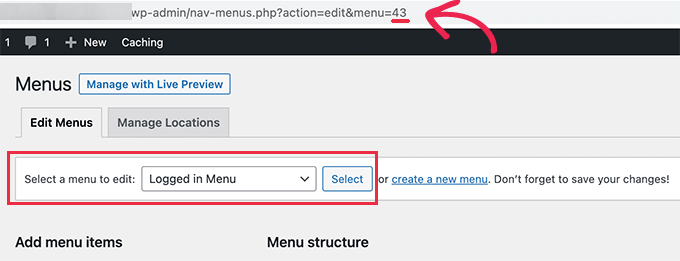
Une fois que vous vous êtes assuré que tous les détails sont corrects, cliquez sur le bouton bleu “Enregistrer l’extrait”.
Et c’est tout ! Nous espérons que cet article vous a aidé à apprendre comment afficher facilement différents menus de navigation aux utilisateurs/utilisatrices connectés sur WordPress. Ensuite, vous pouvez également consulter notre guide sur la façon de permettre aux utilisateurs d’inviter leurs amis à s’inscrire dans WordPress et comment styliser les menus de navigation de WordPress.
Si vous avez aimé cet article, veuillez alors vous abonner à notre chaîne YouTube pour obtenir des tutoriels vidéo sur WordPress. Vous pouvez également nous trouver sur Twitter et Facebook.





Jan-Paul Kleijn
First I thought of a plugin. Gotta quit thinking like that.
Then I saw your post and was sold.
Thank you for posting this, you helped me very nicely.
Phil
Thanks so much for that. Works perfectly.
Ariet
Hello,
This totally works!
But it change my footer menu too.. is there a way where my footer manu stay the same?
Tarron Acuff
So, I have 2 menus. One for the public and another that I would like employees to see when they are logged in. The employee menu would replace the main menu only when an employee is logged in.
Here is what I am currently using in my functions.php file
// Set the Role as a body class
function add_role_to_body( $classes ) {
$user = wp_get_current_user();
$user_roles = $user->roles;
foreach( $user_roles as $role ) {
$classes[] = ‘role-‘ . $role;
}
return $classes;
}
add_filter( ‘body_class’, ‘add_role_to_body’ );
***Here is what I added for CSS***
/* First hide the menu items for non “employee” user */
#top-menu li.menu-for-employee {
display: none;
}
/* Show the menu items for the “employee” user */
.role-employee #top-menu li.menu-for-employee {
display: initial;
}
When I log in as an employee both menus are showing.
Thanks in advance.
Wasim
its not working for me. It display default menu after I add this code, even my primary menu gone.
Joe
Hi Guys,
I nice tutorial but i was wondering could you use the same approach to replace a responsive menu at a certain screen size?
I have two menus but would rather have just one responsive menu at 768 px by replacing the menu with another.
Thanks
Pet
Awesome job with your guides. I am building my first wordpress site and I am finding your site incredibly helpful in guiding me along, thank you.
I really wanted to show different menus for logged in users (like ‘edit profile’) and for logged out users and that brought me here. The code you shared works alright for me. I now have two menus which are showing up nice. However, the last part of the code, add filter string, I believe, is messing me up a little bit. Now, another menu is showing under the sidebar widget. The ‘logged-in’ menu. I am using sydney theme and I have tried to no avail to remove this unnecessary menu. Any idea on how I can make it not display?
WPBeginner Support
Hi Pet,
Please check Appearance » Widgets page to see if you have a custom menu added as a widget there. If it is there then you can just delete that widget.
Admin
Pet
What genius! It worked! Thanks for the wonderful tip!!
Jomcy Johny
Me too have the same problem..Please help me..but I dont have widgets..Thank you..!
Alex Hammerschmied
Works like a charm…
Thanks for that.
Btw i love theses short tutorials
giovanna
Hi can you help me please? I have another trouble please? I need to hide one menu to all and allow only the vendors to see what I have to do please? what is the specific code i have to use please?
ericlee
When you modify the functions.php like so- wouldn’t it get wiped when you upgrade your WP next version ?
WPBeginner Support
Yes, it will get wiped out when you update your theme. To prevent this you can create a site-specific plugin.
Admin
Ramona
Will this work for a Buddypress install? Thanks.
Nikhil Chaudhari
the function set secoundary menu also? i only want to set primary menu. how to do that
Nikhil Chaudhari
this above function set secondary menu all i want to set only header menu?
how to do that
Asfaha
Hi,
thanks a lot for this solution, I’ve applied and woks perfect and saved me installing one more plugin.
Shafaq
this is the code for replacing existing menu to logged user menu by addming location top-menu and with menu loggedin no need else statement with this
add_filter( ‘wp_nav_menu_args’, function ( $args )
{
if( is_user_logged_in() && $args[‘theme_location’] === ‘top-menu’ ) {
$args[‘menu’] = ‘loggedin’;
}
return $args;
});
Ashraf Ali
———————————————————–
function my_wp_nav_menu_args( $args = ” ) {
if( is_user_logged_in() ) {
$args[‘menu’] = ‘logged-in’;
} else {
$args[‘menu’] = ‘logged-out’;
}
return $args;
}
add_filter( ‘wp_nav_menu_args’, ‘my_wp_nav_menu_args’ );
———————————————————–
Now how do i get it to work with
—————————————————
———————————————————————————————————————-
Please Advice
Iqbal Mahmud
If I want to hide a page from logged out user from a single menu what have to do?
Kasper
You can lock pages to hide them from logged out users. There are several plugins that make this very easy to do. Users Ultra comes to mind.
Zev
Everything worked perfectly.
However, I still have the issue of a repeated primary menu in the secondary navigation menu section which I can’t seem to remove (I don’t have a secondary menu set up).
Vince
I’m having the exact issue. The change reflects in the secondary menu location out of nowhere and I too don’t have a secondary menu setup. :/ Please advice how to deal with it.
Thanks in advance.
Chiranjeevi Vinodkumar
LISTEN!!!
Most of us, uses themes.
So first go to the functions.php of your theme.
Search with navigation as keyword.
In case of Shopkeeper theme..
==================================================================
register_nav_menus( array(
‘top-bar-navigation’ => __( ‘Top Bar Navigation’, ‘shopkeeper’ ),
‘main-navigation’ => __( ‘Main Navigation’, ‘shopkeeper’ ),
‘footer-navigation’ => __( ‘Footer Navigation’, ‘shopkeeper’ ),
===================================================================
This is how you look.. so pick the one which is primary, In my case, Its “Top Bar Navigation” hence used “top-bar-navigation”
I used the following code and worked like a charm!!!
This is my way of thanking the author.
Good day !!
Ann Novakowski
Here’s what worked for me with WP . I used this to create a specific primary menu for logged-in Buddypress users. It will NOT affect my footer menu OR social media menu for any visitors, so everyone sees the same secondary menus regardless of whether they’re logged in or not. This is based on all of the comments above (HT to Fransiska!).
Added the following to my Child Theme’s functions.php file:
// CHANGE MAIN MENU =ONLY= IF MEMBER IS LOGGED IN
function my_wp_nav_menu_args( $args = ” ) {
if ($args[‘theme_location’] == ‘primary’) {
if( is_user_logged_in()) {
$args[‘menu’] = ‘logged-in’;
}else{
$args[‘menu’] = ‘logged-out’;
}
}
return $args;
}
add_filter( ‘wp_nav_menu_args’, ‘my_wp_nav_menu_args’ );
Oliver
Don’t know what happened why my comment, but –> ” <– these are correct!
fidel toro
thanks!! help me a lot
Matthias Campbell
Hello,
I added this code (probably wrongly) in my functions.php within my theme in wordpress editor and now I have a constant 500 server error. Even after removing the code.
Before this i attempted to create a site specific plugin but that didnt work. Could you please tell me if the snippet requires an opening and closing bracket?
If so how do i do that?
My host cant help me now and they’re requesting I pay a programmer to help me for 50Eu per hour. Please help me. Its urgent.
I am still logged into wordpress but what ever I click I get the 500 error with this specific error.
PHP Parse error: syntax error, unexpected ‘}’ in line 1194.
This is because I pasted the snippet after all the text in the functions.php file.
I then removed the snippet to see if that would fix it, via editor and FTP and I still get the error.
I look forward to hearing your response.
Kind regards
WPBeginner Support
It depends on where you are adding the code. If there is a closing PHP tag before it then you need to add a php start tag like <?php
If this code is the last thing in the functions file then you don’t need to add a closing tag.
Admin
Hubert
If you have multiple menu locations and want to apply different menus for each location you can use the code bellow:
function my_wp_nav_menu_args( $args = ” ) {
// Primary menu location
if( ‘primary-main’ == $args[‘theme_location’] ) {
if( is_user_logged_in() ) {
$args[‘menu’] = ‘Primary-Logged-In’;
} else {
$args[‘menu’] = ‘Primary-Logged-Out’;
}
return $args;
}
// Secondary menu location
if( ‘secondary-menu’ == $args[‘theme_location’] ) {
if( is_user_logged_in() ) {
$args[‘menu’] = ‘Secondary-Logged-In’;
} else {
$args[‘menu’] = ‘Secondary-Logged-Out’;
}
return $args;
}
}
add_filter( ‘wp_nav_menu_args’, ‘my_wp_nav_menu_args’ );
Haji
This does not work, anyone that does know the proper code if you have 2 or more menus?
Ravikant
Perfect bro .Its work …. awesome work
Leopold
This was almost too easy!
Thanks alot for the simple article.
In this way I don’t have to install any plugin..
Gaurang
I think it is better to use IF MENU plugin. https://wordpress.org/plugins/if-menu/
Creating two separate menus like this, use has to create/update menu twice.
Chris
Hi Gaurang,
I’m curious to know why you feel using the plugin is better, than coding the functions.php file? I was told a while ago to watch how many plugins are actually used for a wordpress site, and the code above seems simple enough; minus the having to monitor every time your theme updates….
Thanks,
Rub
Great, how I can use it to show menu for logged user that have certain role?
Kit Johnson
This worked so simply and neatly. I didn’t think it would be this easy. Thank you!
Jason Sisson
this is awesome tried it. works. but i also would like to redirect by role
is that simple or much harder
Ryan R. Bayne
Thanks. Working with menu functions for the first time.
Creating the WTG Portal Manager plugin which will allow a portal to be defined very quickly. Every portal having it’s own menu. The plugin make the relationship between portal and menu clearer plus provide other unique options.
veer2412
how can i show different posts to different users??
veer2412
thnkx for the help.. but what if i want to show different users different posts on my site.. is there any way to do that using coding??
WPBeginner Staff
Under Appearance > Menus you need to choose a location for your menu. Seems like there are two areas on your site where you can add menus. So you need to create two different menus and then assign a location to them.
Heather Gile
what would the revised code for this be, if there was a distinction of ‘Primary’ and ‘Top’?
$args[‘primary-menu’] = ‘logged-in’;
$args[‘top-menu’] = ‘logged-in’;
else
$args[‘primary-menu’] = ‘logged-out’;
$args[‘top-menu’] = ‘logged-out’;
?
Kyle
WordPress will not let me put 2 menus in my “top header” location. The code you provided works, but it changed ALL of my menus to the logged in or out, and is not displaying my normal nav menu
b2995
I have a top menu as well as a site menu (under logo). How would I change the code to switch just that top menu. Right now, ALL my menus change.
Harry Slyman
You saved my day! thank you
Rob
OMG, this made me laugh it was so simple… thank you!
Melih
Illustrative and easy, thank you so much.
Rohit Gahlot
Working .. Thanks a lot
Thanks a lot
Seth
Thanks for this.
On the homepage, menu names that have a submenu (a drop-down menu) do not show the drop-down. When I go to any other page that isn’t my homepage, this isn’t a problem, and all menu items are shown.
This is the case on the homepage for both logged-in and logged-out items. Any idea how to fix this? Thanks
http://www.viridianmgt.com/wordpress
WPBeginner Support
Seems like a theme issue. Contact your theme support.
Admin
Wouter Bredenbeek
Only changing a certain menu can be achieved by changing $args[‘menu’] = ‘logged-in’;
into $args[‘secondary-menu’] = ‘logged-in’; for example. Should do the trick!
DANIEL
That code doesn’t work. I have registered a ‘primary-menu’ and ‘secondary-menu’ and trying the function provided with your change in args no menú changes.
I fix this using this code:
function my_wp_nav_menu_args( $args = ” ) {
if ($args[‘theme_location’] == ‘secondary-menu’) {
if( is_user_logged_in()) {
$args[‘menu’] = ‘logged-in’;
}else{
$args[‘menu’] = ‘logged-out’;
}
}else{
$args[‘menu’] = ‘Principal’;
}
return $args;
}
add_filter( ‘wp_nav_menu_args’, ‘my_wp_nav_menu_args’ );
NOTE: ‘ Principal is the name of the primary static menu.
Rory PQ
So close, both my footer and main menus are changing. I’m trying to just change my footer menu. I’ve tried so many variations of this code but no dice. Any solution thoughts?
When I inspected my theme with Firebug it said my footer is “id=footer-nav”. Should I use this name rather than “secondary-menu”?
Many Thanks
lemonthirst
Hurray! Finally found it, it never crossed my mind that this simple function would ease up my work so much.
Thank you guys!
Grant
When I try to enter the code into the functions.php file it gives me the following error:
Parse error: syntax error, unexpected ’03’ (T_LNUMBER) in /home/grantkessler/public_html/wp-content/themes/GameNews/functions.php on line 201
Stevie Allison
Perfect just what I was looking for. i´m going to try it now. Thank You
Stevie Allison
It works perfect. Thank You
Alex
Big thanks for sharing code but it really add this menu in all areas! Is there a way to show it only in specific menu ?
shanewaj rahman
Thanks,
You made it so easy.
zaman
I created site specific plugin and menu’s working fine, but my footer menu is also changed, its not showing the one i selected but the logged-in or logged-out.
WPBeginner Support
Zaman WordPress menus have locations assigned to them. Make sure you are using a different menu for the footer menu location.
Admin
Grant
Hi when I try to put in the code it messes up my site completely giving the error message:
function my_wp_nav_menu_args( $args = ” ) { if( is_user_logged_in() ) { $args[‘menu’] = ‘logged-in’; } else { $args[‘menu’] = ‘logged-out’; } return $args; } add_filter( ‘wp_nav_menu_args’, ‘my_wp_nav_menu_args’ );
Warning: Cannot modify header information – headers already sent by (output started at /homepages/5/d156331781/htdocs/reviewthegame/wp-content/themes/Made-Theme/made/functions.php:12) in /homepages/5/d156331781/htdocs/reviewthegame/wp-includes/pluggable.php on line 899
joseph
Is there a way to only apply this to a specific menu?
I have tried this:
if( $args->theme_location == ‘primary-menu’ ) {
//Code here
}
but it doesn’t work. any ideas how to achieve this?
shanewaj rahman
This is what I have done to over come two menu problem.
I have removed that function and put this code in the header.php
where I was calling my menu.
false,
‘menu_id’ => ‘nav’,
‘menu’ => ‘Registered’,
‘items_wrap’ => ‘%3$s’)
);
}
else
{
wp_nav_menu( array(‘container’ => false,
‘theme_location’ => ‘primary’,
‘menu_id’ => ‘nav’,
‘items_wrap’ => ‘%3$s’,
) );
}?>
Fransiska
Use
if ($args[‘theme_location’] == ‘primary’)
instead and it’ll works
Gerald Tyler
Fransiska, can you explain your suggestion further? I have several sub-menus I’m putting in sidebars, and the solution on this page makes all those short menus now full menus with all of the Primary menu names, none of my various custom menus. Your suggestion sounds like we can apply this trick to just the primary menu position, not the sidebars. Make sense? Can you provide the full code? I’m not having any luck guessing on how it goes together.
joseph
Oct 25, 2013 at 1:16 am
Is there a way to only apply this to a specific menu?
I have tried this:
if( $args->theme_location == ‘primary-menu’ ) {
//Code here
}
but it doesn’t work. any ideas how to achieve this?
Fransiska
Jan 31, 2014 at 2:53 am
Use
if ($args[‘theme_location’] == ‘primary’)
instead and it’ll works
Jamie Mannion
Great tip, that came at a perfect time in my site development.
Works a treat! I think I’ll extend on this to show different menus for different user_meta.
Thanks for sharing!
karen
Hi, thanks for that, most helpful. though I’m still not sure where to put the code?
(After creating the menus, add this code in your theme’s functions.php file or a site-specific plugin) – where is the functions.php file?
cheers
WPBeginner Support
Go to Appearance » Editor you will see functions.php file in the list of files on your right hand. However, if you do not see a functions.php file there, then this means you are using a theme framework or a child theme. In that case you need to create a site specific plugin for your site and add this code inside that plugin. See our guide on site-specific plugin.
Admin
Cathy Earle
Great tip. Looking forward to using it in an upcoming design.